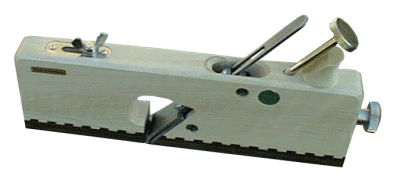|
|
|
E.C. Emmerich 710-P Plane Review
| Description These planes are in a category of extremely useful tools I generally regard as "problem solvers". These planes are generally used to fix depthing mistakes, remove machining marks, and quite often to make final sizing fits to doors and other similar parts. They can often be used to tune mating pieces such as lap joints too. A good analogy of their use would be; "you wouldn't build a Pennsylvania Highboy with one - but you could make one fit together better using one". |
 |
| The ECE model 710-P Rabbet plane is made of wood with a long
wearing Lignum Vitae sole. The body is basically a big rectangular block. The blade is
held in place by a slightly smaller version of the Primus adjusting mechanism found other
ECE planes. The entire section of the sole in front of the blade is moveable fore and aft
to control the blade opening; if you didn't know it was there you might miss it because
the seam is invisible. It is locked into the desired position via a thumb screw on the top
of the body. Aside from cleaning the blade, the plane was basically ready to use right out
of the box. The other metal rabbet planes I am aware of are basically miniature planes in most respects. Of coarse the overall size is smaller than a smoothing plane for example (as would be expected) but this also means that EVERYTHING is generally smaller in scale. As a result, pieces that bed, adjust, and clamp the blade and body are all small and generally not exceedingly substantial. The design of the 710-P is in stark contrast to this, all of its parts are essentially full-size, it's basically a section of a full size plane - not a miniature. This directly translates into reasonably sized components and adjustment controls that are useable without resorting to screw drivers and wrenches. Ergonomics A rabbet plane such as this is going to be long and narrow by design so there isn't a lot of opportunity to create a form fitting body. However, that does not mean that ergonomics does not come into play. Being taller specifically allows the user a better feel to maintain the desired (presumably square) cutting angle. Even though the 710-P is quite a bit larger it weighs less than the metal rabbet planes I know of. Being lighter and having a natural self-lubricating sole seems to make the plane a little easier to push as well. Comparisons My point of reference for the 710 comes from the Stanley #92. The most immediately obvious performance difference between the 710-P and my metal plane is in chip ejection. The Stanley tends to accordion a ribbon of wood into the throat opening that must be manually cleared on nearly every single pass of the tool. By contrast, I could hardly get the chip to stay in the throat of the 710-P even when I tried. The Stanley is very easy to jam up; having to clear the tool nearly every pass is a significant frustration that is solved by using the 710-P. Adjusting the depth of cut on other rabbet planes can be a bit of a chore. This is another area where the 710-P shines, adjusting the blade depth or throat opening is remarkably simple, quick, and accurate. Using equally sharp blades, the 710-P was not quite as smooth as the #92 cutting with the grain but just as smooth cutting across the grain; the difference between the two would not make the 710-P a poor performer. Summary The 710-P is harder to find than the small metal rabbet planes, its clearly superior performance overall make it well worth your effort to seek it out. Other reviews of ECE planes are the 711 Smooth and 741-P English Pattern Jack planes |
|